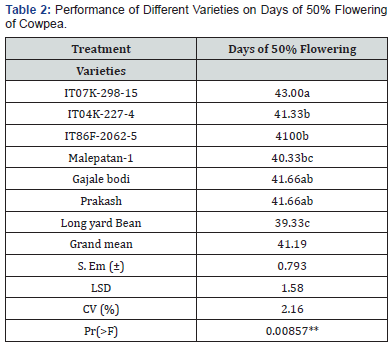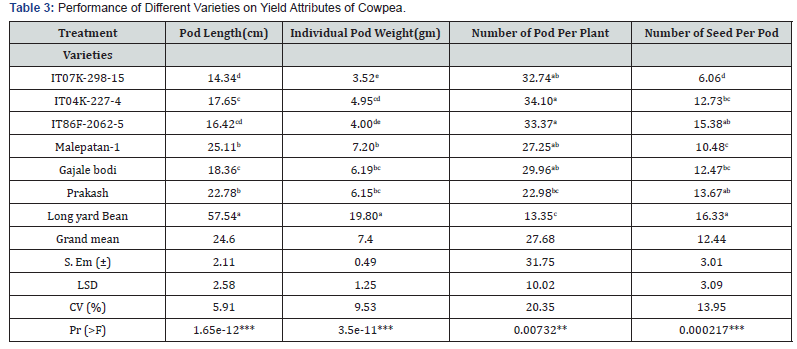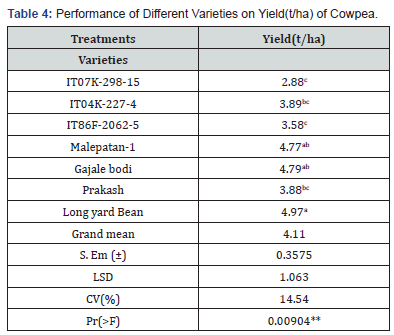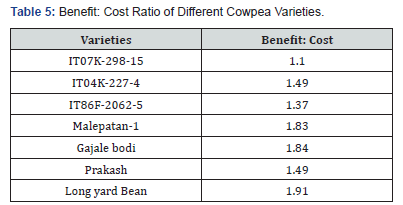Germplasm Evaluation of Cowpea (Vigna unguiculata (L.) Walp.) in Dang District
Kandel P1, Sharma P1, Subedi S1, Gupta S1, Bhattarai1 and M Basent2*
1 Institute of Agriculture and Animal Science, Campus of Live Sciences, India
2 Institute of Agriculture and Animal Science, Nepal
Submission: October 21, 2019; Published: November 05, 2019
*Corresponding author: M Basent, Institute of Agriculture and Animal Science, Paklihawa Campus, Nepal
How to cite this article: Kandel P, Sharma P, Subedi S, Gupta S, Bhattarai, M Basent. Germplasm Evaluation of Cowpea (Vigna unguiculata (L.) Walp.) in Dang District. JOJ Wildl Biodivers. 2019: 1(5): 555572. . DOI: 10.19080/JOJWB.2019.01.555572
Abstract
A trail on production performance of cowpea genotype received from the Horticulture Research Division, pokhara-5, Malepatan, kaski was carried out at Horticulture farm of campus of live sciences from July 2018 to evaluate cowpea genotype suitable for the dang district of Nepal. Three different cowpea genotypes with four check varieties were tested on Randomized Complete Block Design (RCBD) with three replications. Data were obtained on Days of 50% Flowering, Plant Height, Number of branches, Number of Leaves on Plant, Pod Length, Individual Pod Weight, Number of Green Pod per Plant, Number of Seed per Pod, Yield per Plant, Yield per Plot, yield per hectare were obtained. Tested genotypes differed significantly for vegetative as well as yield parameters. According to the result there is highly significance in the pod length between the variety. The Highest pod length was obtained from long yard bean (57.54cm) followed by Malepatan-1(25.11cm) , Prakash (22.78cm), Gajale-bodi(18.36cm), IT04K-227-4(17.65cm), IT86F-2062-5(16.42cm), IT07-298-15(14.34cm). The highest pod weight was found in Long yard bean (19.80g) while lowest from IT07-298-15(3.52g).The highest yield (4.97 t/ha) was recorded from long yard bean followed by Gajale body(4.79 t/ha), Malepatan-1(4.77t/ha),IT04-227-4(3.89t/ha),Prakash(3.88t/ha),IT86F-2062-5(3.58t/ha) and the lowest (2.88t/ha) from IT07K-298-15. Data from economic analysis revealed that long yard bead leads to significant high B: C ratio calculated 1.91 and the lowest 1.10 in IT07K-298-15.Based on the results obtained, Long yard bean genotype gives highest yield and better B/C ratio compare to other genotype in the dang condition.
Keywords: Genotype; Evaluation; Cowpea; Dang; Economic analysis; Genotype; Green Pod; Long yard bean; Horticulture
Introduction
Cowpea (Vigna unguiculata L.) is one of the versatile leguminous vegetable contributing to the health and livelihood of millions of people in tropical and sub-tropical countries, and Asia Rachie KO [1] and having much more protein than other vegetables and it could be a thrives well in warm weather due to its drought-tolerant capacity. Islam emphasized that all parts of the plant used as food are nutritious providing (20-24%) protein, (63.3%) carbohydrates and (1.9%) fat in cowpea seeds Gopalan [2]. Their mineral contents: calcium and iron are higher than that of meat, fish and egg Achuba [3] which make them very useful in blood cholesterol reduction. In Nepal, cowpea can be grown successfully both in spring-summer and rainy-autumn seasons in the plains and hills. It does not require a high rate of nitrogen fertilization; its roots have nodules in which soil bacteria called Rhizobia help to fix nitrogen from the air. Most vegetables crops can successfully be grown from Terai to the high hills in normal and off-season provided appropriate varieties and technologies for production Pandey & Pokhrel [4].
In Nepal, despite the fact that a large number of varieties and agro-techniques have been developed but the productivity of cowpea has still not reached the desired level. Ndiaga [5] concluded that cowpea cultivars with different plant morphology would require different optimum environmental conditions to express their full seed yield potential. The success of most crop improvement programmed largely depends upon the genetic variability and the heritability of desirable traits in reproductive period and grain yield of cowpea under high temperature condition and the duration of reproductive period Singh [6]. Varietals differences of cowpea in terms of growth pattern, seed maturity date is extremely diverse from plant to plant, making breeding programs for cowpea more complex than other crops. Therefore, there is great need for genetic improvement and farmers can attribute development of cowpea varieties with acceptable and better traits, which can be achieved through the study of the different growth and yield component, which occur in different varieties of cowpea as low seed yields to unfavorable agronomic practices. Some of the superior varieties were collected from different parts of the country developed by research institutes and evaluated with keeping view of hunt the variety with unique features useful for the growth, seed yield, quality attributes, and which would go a long way to help the vegetable crop production. In Nepal Cowpea is generally grown in marginal land with little or no inputs and therefore the yield is very low. The estimated area, production and yield are 4620.7 ha, 56790.10 metric ton and 12.3mt/ha respectively. While in Dang, the area coverage of fresh cowpea was 120ha and yield was 15 mt/ha. Area and production are increasing every year because of availability of dual purpose (green pods as vegetable and dried pulse) short duration varieties. (MOA STST 2072-2073).
Materials and Method
The study was conducted in the Horticulture field of Mid-western Academy and Research Institute, campus of live sciences located at Tulsipur sub-metropolitan of dang district in Rapti zone, which is at province 5. The cowpea seeds used for the study were obtained from the Horticulture Research Division, pokhara-5, Malepatan, kaski. The seven-cowpea varieties were evaluated i.e. IT07K-298-15, IT04K-227-4, IT86F-2062-5, Malepatan-1, Gajale body, Prakash and long yard bean. In field trials, the cowpea varieties were arranged in a Randomized Block Design with three replications. Sowing took place on July 24, 2018, at the beginning of the rainy season having the individual plot size 2.56m²(1.6m*1.6m). Plant spacing was maintained 40cm ×20cm. Compost 6 tons and NPK 20:40:20 kg/ha was applied as basal dose during field preparation. A standard insecticide, cypermethrin 2ml/l was applied at 25 DAS to control flowers Thrips, aphid etc. To raise the crop recommended package of practices were followed. The different varieties were evaluated based on growth, flowering and yield performance. The various parameters were recorded from five randomly selected tagged plants. All the recorded data were compiled and analyzed through RSTAT package. The mean data were subjected to statistical analysis following analysis of variance technique. Cost of cultivation was calculated on the basis of local rates of inputs used during the research, gross return was calculated from the value of grain yield/ha and the difference of gross return and cost of cultivation was the net return obtained then the Benefit: Cost ratio was calculated for the purpose of economic analysis.
Result and Discussion
Growth parameters
The growth attributes were analyzed and presented in (Table 1) reveals that growth parameter of different genotype in regards to plant height is highly significant (at 1% level of probability) till 15 days after sowing with highest plant height of 27.59 cm in case of Gajale Body followed Malepatan-1 (25.53 cm), IT04K-227-4 (24.90 cm), long yard bean (24.82 cm), Prakash (24.54 cm), IT86F-2062-5(24.30 cm) and lowest in case of IT07K-298-15(20.63 cm). Result reveals that plant height is significant (at 1% level of probability ) till 25 DAS with highest plant height of 45.20 cm in case of long yard bean that results quit resemble to Sapkota et al.2015(37.60 cm) and the lowest in case of IT07K-298-15(26.62cm). And at 35 DAS result reveals that plant height is significant (at 5% level of probability) with highest plant height of 104.69cm in case of long yard bean and the lowest in IT07K-298-15 (37.77cm). The huge variation in plant height might be due to the genetic characteristic of the individual varieties Kelechukwu [7].

With respect to number of branches per plant, the different varieties of cowpea varied clearly. It is evident from the table 1 that the number of branches per plant increased under various treatments at 15 DAS, 25 DAS and at 35 DAS. From the data, it is clear that among varieties, the number of branches were significant (5% level of probability) at 15 DAS and 35 DAS but found non-significant at 25 DAS. The number of branches range from 1.60 to 2 at 15 DAS in which highest branches number was foundin IT86F-2062-5(2) and IT04K-227-4 (2) whereas lowest at malepatan- 1(1.60). While at 25 DAS there is no variation in the number of branches between the varieties. At 35 DAS the number of branches ranges from 5 to 9.53 where highest branch number was shared by Gajale bod (9.53) and the lowest by the long yard bean (5). Variation in the number of branches per plant showed high values for heritability and genetic advance, suggesting that great scope for crop improvement exists Thaware [8].
In case of number of leaves per plant variation among the different varieties were observed. Variety Prakash had significantly lower number of leaves per plant where as Variety Gajale body produced significantly higher number of leaves per plant at 15 DAS. There is no significance between the varieties in case of number of leaves per plant at 25 DAS. However, there is significant (at 5% level of probability) at 35 DAS. Variety Gajale body produced higher number of leaves per plant while the variety long yard bean had significantly lower number of leaves per plant at 35DAS. Akundabweni [9,10] also reported that there is positive correlation in between high pod and grain yield and number of leaves per plant. They found that lower total fresh leaf yields were associated with early to medium flowering and high total pod and total grain yields (Table 1).
Days of 50% flowering
The data presented in Table 2 revealed that there was a significant variation in days taken for 50% flowering. Minimum days for flowering were taken by the variety long yard bean (39.33 days) which was statistically at par with Malepatan-1 (40.33 days). Whereas, maximum time for flowering was taken by variety IT07K-298-15 (43.00 days) which was also statistically at par with Prakash (41.66 days) and Gajale body (41.66 days). In this experiment, time taken for 50% flowering varied from 39.33 days to 43 days. NGLRP (2000) reported that Prakash was the earliest in flowering (40 days) and the cowpea varieties flowered earlier (43 days) at Rampur than Surkhet (51 days) and Nepalgunj (52 days). Yohana (2014) reported that time taken for flowering varied from 50.67 to70.17 days under Nigerian condition. Variation in days taken to flowering in different location might be due to the different Agro climatic condition and variation in studied varieties (Table 2).

Yield parameters
Pod length: The data presented in Table 3 revealed that the pod length varied significantly in all the varieties. Significantly longest pod was produced in long yard bean (57.54 cm) followed by malepatan-1 (25.11 cm). Significantly shortest pod length was recorded in IT07-298-15 (14.34 cm) followed by IT86F-2062-5 (16.42 cm) which was statistically at par with IT04K-227-4 (17.65 cm), Gajale bodi (18.36 cm) and prakash (22.78 cm). Pandey et al., (2006) reported that pod length varies from 16.21 to 25.60 cm. Sapkota et al, [11] reported that pod length of long yard been found to be 39.5 cm on non-mulched condition. Magashi et al, [12] reported that pod length varied from 13.77 cm to 16.50 cm under Nigerian condition. Khan et al, [13] reported that pod length ranged from 10 to 38 cm under Pakistan condition. Variation in pod length of cowpea might be due to variation in agro-climatic condition and variation in genotypes.
Individual pod weight: There was a significant variation in pod weight among the different varieties as shown in table 3. Individual pod weight varied from 3.52g to 19.8g with respect to different varieties of cowpea. Significantly highest individual pod weight was recorded in long yard bean (19.8g) and it was lowest in IT07K-298-15 (3.52g).The higher individual pod weight was also recorded in Malepatan-1 (7.2g), Gajale body (6.19g), Prakash (6.15g). The lower individual pod weight was also recorded in IT86F-2062-5 (4g) and IT04K-227-4 (4.95g). The higher individual pod weight was might be due to the higher fruit length and diameter. In this experiment, variation in pod weight was recorded with respect to different varieties. Variation in pod weight might be due to the variation in pod length among the different varieties studied. Peksen [14] also reported that there is a significant and positive correlation in between pod length and individual pod weight. Similar findings were also reported in present experiment.
Number of green pod per plants
The observation on number of pods per plant has been presented in Table 3, which indicated that different cowpea genotypes showed a variation among themselves with respect to number of pods per plant. On the basis of analysis, highest number of pods per plant was recorded in IT04K-227-4(34.1) which was statistically at par with IT86F-2062-5 (33.37), IT07K-298-15 (32.72). Whereas, the lowest number of pods per plant was recorded in long yard bean (13.35) which was also statistically at par with Prakash (22.98). In this experiment number of pods per plant varied from 13.35 to 34.1. In general, higher the number of pods/ plants more pod yield is obtained but the results of the experiment showed that fruit size (length and diameter) and weight of individual pod is also determining factor for yield estimation. Pandey & Singh [15] also reported the significant variation in number of pods per plant among the different varieties of cowpea, which is similar in the present experiment (Table 3).
Number of seed per pod
The observation on number of seed per pod has been presented in Table 3 which indicated that different cowpea genotypes showed a significant variation themselves with respect to number of seed per pod per. Varieties Long yard bean and IT86F-2062-5 had produced the maximum number of seeds pod-1 16.33 and 15.38 respectively, .which were at par, followed by Prakash(13.67) , IT04K-227-4(12.73), Gajale bodi(12.47) , Malepatan-1(10.48) and IT07K- 298-15(6.06). Amanullah [16] found that there is a positive relation between the number of seed per plant and the individual pod weight that directly influenced the yield of the variety. In this experiment Long yard bean (16.38) had the highest number of seed per pod and having the highest individual pod length. represent significant at 5% level of probability, represent significant at 1% level of probability and represent significant at 0.1% level of probability

Yield
The highest yield per plant was recorded in Long yard bean (199.27g) which was also statistically at par with Gajale bodi (193.72 g).The lowest individual plant yield was recorded in IT07K-298-15 (115.55g) which was statistically at par with IT86F-2062-5 (143.54 g). This might be due to the higher number of pods per plant and moderate to higher individual pod weight. Pandey & Singh [17] also observed similar finding. The data presented in Table 4 showed that yield (tones/ha) varied significantly (at 1% level of probability) with respect to different varieties. Among the different varieties maximum yield was recorded in Long yard bean (4.97 tonnes/ha). Higher yield was also recorded in case of Gajale (4.79 tonnes/ ha) followed by Malepatan-1 (4.77 tonnes/ha), Prakash (3.88 tonnes/ha), IT04K-227-4 (3.89 tonnes/ha), IT86F-2062-5 (3.58 tonnes/ha) and IT07K-298-15 (2.88 tonnes/ha) respectively. In this experiment, yield varied from 2.88 tonnes/ha to 4.97 tonnes/ha, this might be due to variation in genetic makeup of the variety. Such variation in the yielding ability of the genotypes was also reported by Ram [18], Mahammad [19] and Amanullah [16]. Higher yield of the above varieties might be due to the moderately higher number of pods per plant, pod length and individual pod weight. Different scientists like, Rajput [20], Neema [21] and Pandey [17] observed variation in yield of the different varieties (Table 4).

Economic analysis
It is an actual monetary gain by each rupee of investment under a treatment. It can be expressed as profitability also. The selling price of Cowpea was NRs. 40/Kg and the cost of cultivation was calculated NRs 1, 04,000. Based on these rates and the then market prices of other inputs used following economic calculation were made. Data on Benefit: Cost ratios as affected by different treatments were given in (Table 5).

Conclusion
Production of cowpea in Nepal is limit by lack of improved varieties and seeds. Majority of germplasm introduced in Nepal were not characterize for adaptation and as such their usefulness for deployment in breeding programs as well as considered for release to farmers cannot be ascertained. To effectively determine the usefulness of any introduced germplasm accessions, evaluation is necessary [22-24]. From the studies, it may be concluded that higher yield of cowpea may be obtained from the varieties having higher individual yield, plot yield, number of pods per plant, individual pod weight, early 50% flowering in nature. This study revealed that cowpea varieties such as long yard bean, Malepatan- 1 and Gajale bodi, which gives the better yield as compare to the other varieties. Results on economic analysis demonstrated that in ‘Long yard bean’ shows the higher B/C ratio than other varieties so selection this variety can be profitable to the cowpea- producing farmer of the dang district.
Acknowledgement
We are indebted to the staff of Horticulture Research Division, Pokhara, Malepatan for providing the seeds and for their technical assistance. The research presented in this manuscript is partially supported by Jit-Shavitra Research Mini-grant through the scholarship of Academic Excellence Program of Association of Nepalese Agricultural professionals of America (NAPA) on any products of this research. We also thank our advisor Assistant Professor Manoj Basnet, Department of Horticulture, IAAS, Paklihawa, for his guidance on data analysis and invaluable comments on the draft manuscript.
References
- Rachie KO (1985) Cowpea Research Production, and Utilization. In: SR Singh, KO Rachie, (Edt,). John Wiley & Sons, USA, pp. 460.
- Gopalan C, Rama SBV, Balasubramanian SC (2007) Nutritive Value of Indian Foods- revised edition. National Institute of Nutrition, Indian Council of Medical Research Hyderabad India P. 50 in the Norther n Guinea Sabvanna ecology of Nigeria. The International Journal of Engineering and Science 3(2): 44-47.
- Achuba FI (2006) The effect of subletethal concentration of crude oil on the growth and metabolism of cowpea (Vigna unguiculata) seedlings. The Environmentalist 21(1): 17-20.
- Pandey YR, TR Pokhrel (2000) Varietal evaluation of late season cauliflower. In: KP Paudyal, PP Khatiwada and BB Khatri, (Edt.), Proceedings of the Third National Horticultural Research Workshop. Horticulture Research Division-NARC, Khumaltar, Nepal, p. 46-49.
- Ndiaga C (2000) Genotype x Row Spacing and Environment interaction of cowpea in semi-arid zones. African Crop Science Journal. 9(2): 359-367.
- Singh BB (1997) Performance of promising cow pea varieties at mingibir, Annual Report, Project II Cowpea Cereals System Improvement in the Savanna, p.14-15.
- Kelechukwu N E, Adewale M O, Ezekicl A A, (2007) Aluminum influence on performance of some cowpea (Vigna unguiculata L. Walp.) varieties on a Nigerian alfisol. World journal of Agricultural Sciences 3(4): 512-522.
- Thaware B L, Birari S P, Jamadagni B M (1991) Genetic parameters and correlation studies in forage yield components of cowpea. Journal of Maharashtra Agricultural Universities 16(2): 261-262.
- Akundabweni L S, Peter P C, Singh B B (1990) Evaluation of elite lines of cowpea (Vigna unguiculata (L.) Walp.) for leaf/fodder plus grain (i.e. dual purpose) 67(2): 133-136.
- Akundabweni L S, Peter P C, Singh B B (1990) Evaluation of elite lines of cowpea (Vigna unguiculata (L.) Walp.) for leaf/fodder plus grain (i.e. dual purpose).
- Sapkota A, Poudel S, Subedi U, Shrivastav R, Gairhe JJ (2015) Effect of Mulching and Different Doses of Phosphorous in Cowpea (Vigna unguiculata L.) Yield and Residual Soil Chemical Properties at Bhairahawa, Nepal. World Journal of Agricultural Research 3(5): 163-173.
- Magashi I, Musa A, Fulani S and Ibrahim M. 2014. Evaluation of the cowpea (Vigna ungiculata (L.) Walp) genotypes for some yield and root parameter and their usage in breeding programme for drought tolerance. International Journal of Advances in Agriculture and Environmental Engineering 1: 34-37.
- Khan A, Bari A, Khan S, Shah N H and Zada I. 2010. Performance of cowpea genotypes at higher altitude of NWFP. Pakistan Journal of Botany 42(4): 2291-2296.
- Peksen A (2004) Fresh pod yield and some pod characteristics of cowpea (Vigna unguiculata (L) Walp) genotypes from Turkey. Asian Journal of Plant sciences 3(1): 269-273.
- Pandey Y R, Pun A B, Mishra R C (2006) Evaluation of vegetable type cowpea varieties for commercial production in the river basin and low hill areas. Nepal Agriculture Research Journal 7: 16-20.
- Amanullah M, Hatam, Ahmad N (2000) Performance and distinguishing characters of promising cowpea germplasm. Sharad Journal of Agriculture 16(4): 365-369.
- Pandey B and Singh Y V (2011) Genetic variability in indigenous and exotic varieties of cowpea. Pantnagar Journal of Research 9(2): 234-240.
- Ram T, Ansari M M, Sharma T V R S (1994) Relative performance of cowpea genotypes in the in the rainfed condition of Andaman and their genetic analysis for seed yield. Indian Journal of Pulse Research 7(1): 72-75.
- Mohammad N, Sartaj (1989) Performance of cowpeas cultivars under rainfed conditions at Narc, Islamabad. Sarhad Journal of Agriculture 5(6): 615-618.
- Rajput J C, Thorat ST, Shinde PP, Palve S B (1991) Evaluation of cowpea genotypes for vegetable purpose. Annals of Agricultural Research 11(3-4): 325-326.
- Neema V P, Bridgit T K, James K I, Nair N R (1991) IIHR 61-B, a high yielding vegetable type of cowpea. Agricultural Research Journal of Kerala 29(1-2): 45-48.
- Tropical Alghali AM (1991) Studies on cowpea farming practices in Nigeria with emphasis on insect’s pest control. Tropical Pest Management 37: 71-74.
- NGLRP (2000) Annual Report. National Grain Legume Research Programme, Rampur, Chitwan, Nepal, p. 39-43.
- Yohanna M (2014) Evaluation of some cowpea (Vigna ungiculata (L.) Walp) genotypes at Mumbai.






























